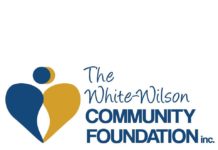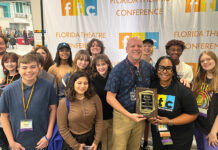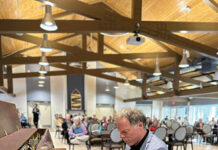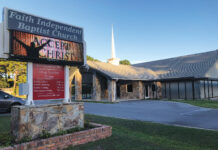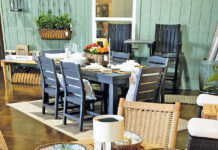By Michelle Ruschman
 Foster parenting helps kids and enriches families. A common misunderstanding about fostering is that foster families are gatekeepers between children and biological parents. April Hight, the Foster Home Recruitment Specialist with FamiliesFirst Network for Okaloosa and Walton County, wants to clarify that a foster parent is more in the position of being a bridge between a child and their parent(s), with the ultimate goal being reunification. A foster family is part of their healing process.
Foster parenting helps kids and enriches families. A common misunderstanding about fostering is that foster families are gatekeepers between children and biological parents. April Hight, the Foster Home Recruitment Specialist with FamiliesFirst Network for Okaloosa and Walton County, wants to clarify that a foster parent is more in the position of being a bridge between a child and their parent(s), with the ultimate goal being reunification. A foster family is part of their healing process.
It’s important to make these distinctions, because as our community looks at the aftermath of Covid and lockdown, foster family recruiters like April are finding that a critical area that has been directly affected is the available beds for displaced children. The hope is that local families will consider becoming part of the fostering community, so the losses from 2020 are recovered. Not having beds for this vulnerable group creates additional hardship in an already difficult situation. “In our area, we have about 460 kiddos, give or take, in need of foster care every day,” said April. “Across our county, we have about 360 available beds. That’s approximately 100 children who don’t have a local bed each day.
 When families are in need, our agency is going to call every licensed home to make sure there is a place here where we can put these children, but oftentimes, they will be sent out of our circuit which includes Okaloosa, Walton, Santa Rosa, and Escambia counties. If we don’t have a bed in these areas, they may be sent to a different part of the state and sadly, that is pretty common. Due to the lack of beds, it’s very unlikely that they’re going to stay in their community once they are removed from the home. This means they’re not going to stay in the same school, be near the things that they know, or be anywhere that is familiar. They have to go where there’s an available bed.
When families are in need, our agency is going to call every licensed home to make sure there is a place here where we can put these children, but oftentimes, they will be sent out of our circuit which includes Okaloosa, Walton, Santa Rosa, and Escambia counties. If we don’t have a bed in these areas, they may be sent to a different part of the state and sadly, that is pretty common. Due to the lack of beds, it’s very unlikely that they’re going to stay in their community once they are removed from the home. This means they’re not going to stay in the same school, be near the things that they know, or be anywhere that is familiar. They have to go where there’s an available bed.
What is sad is that a lot of our kids bounce. A foster home may be full, but will take a child for a few days to give us time to find a permanent spot. At the end of those few days, just as they’re getting comfortable, they have to go to a whole new home. These kids have to say goodbye again, go to another strange place, and it’s just more loss and grief every time they have to move.”
There are multiple reasons children are removed from their homes. But, the top two are substance abuse and neglect. When a child is moved into a home where even the community isn’t familiar, it leads to more trauma.
April and her counterpart in Escambia and Santa Rosa county, Thomas Williams, provide education and support to potential foster families as they on-board into the foster licensing process. There are five levels of licensure in which a family can qualify: Level one is a family member, level two is the largest group with traditional foster care, and levels three to five are more specialized in physical and therapeutic needs. “To receive a license as a level two home, they need to have adequate space in their home to accommodate the children and every child must have their own bed,” said April.
Sleeping arrangements can vary based on the age and gender of the child, but some children also come with the specific stipulation that they need their own room. If a higher level is applied for, it may require that the home has a medical bed. “The initial step in getting a license is to talk to a foster home recruiter like myself.”
The profile of a foster family can vary. In addition to traditional families of all sizes, April has also seen great success with single parents and those who are old enough to be grandparents.
“The ideal foster parents are those who can have empathy for biological families,” said April. “They are willing to learn about trauma and have a flexible parenting style.”
April also stresses the importance of internal work before an individual, a couple or a family considers opening their home. “Have conversations with those who are closest to you, whether that’s your extended family, your church, people you work with or your friend group. Make sure you have adequate support, because you’re going to need a support system,” she said. “Couples have to be on the same page and both have to be fully vested. Include the children in the conversation, because they sacrifice space and time while sharing their home.”
Once you become a foster family, there is ongoing support. In addition to a small stipend to help with the cost of the additional child(ren) in your home, a care coordination arm of FamiliesFirst Network helps navigate challenging situations while offering practical solutions. Online support, Facebook page support and Zoom calls are available for even easier access. “The best support is other foster parents and it’s a great community ready to help,” said April.
If you’re interested in providing one of the needed beds in Okaloosa and Walton counties, or you’d like to know how your church, business or agency can support local foster families and displaced children, visit www.elakeviewcenter.org, contact April Hight at april.hight@bhcpns.org or call 850-982-5364.
























